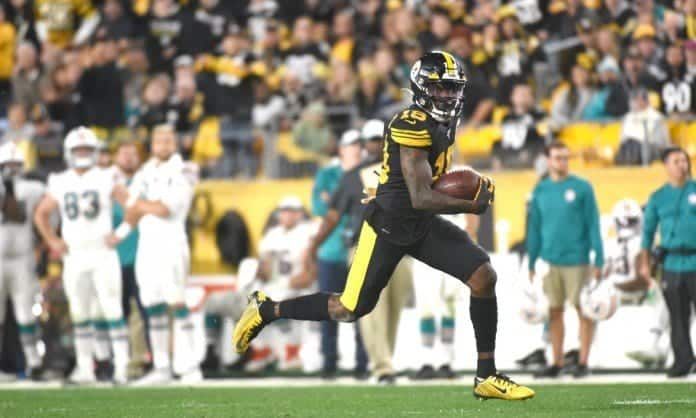We’re already through Week 8 of the 2019 NFL season and, per PFN’s OSM (Offensive Share Metric), we’re seeing a lot of rookies making an impact on their teams. Many pass-catching rookies, both wide receivers and tight ends, have qualified for overall 2019 OSM grades. Of those that have qualified for overall grades, seven rookies have also qualified for weekly OSM grades in at least 50% of the games they’ve played in.
- D.K. Metcalf – WR Seattle Seahawks – Round 2, Pick 32 (64th overall, Mississippi)
- Darius Slayton – WR New York Giants – Round 5, Pick 33 (171st overall, Auburn)
- Diontae Johnson – WR Pittsburgh Steelers – Round 3, Pick 2 (66th overall, Toledo)
- Marquise Brown – WR Baltimore Ravens – Round 1, Pick 25 (25th overall, Oklahoma)
- Mecole Hardman – WR Kansas City Chiefs – Round 2, Pick 24 (56th overall, Georgia)
- Preston Williams – WR Miami Dolphins – Undrafted (Colorado State)
- Terry McLaurin – WR Washington Redskins – Round 3, Pick 12 (76th overall, Ohio State)
For those unfamiliar with OSM, it is a unique way to measure an individual’s contribution to his team’s offensive production. For example, assume Mason Rudolph (Pittsburgh Steelers) completes a 20-yard pass to JuJu Smith-Schuster, who then runs upfield for an additional 20 yards. Traditionally, both Rudolph and Smith-Schuster would be credited for 40 yards gained as a passer and a receiver, respectively. With OSM, Rudolph would only receive credit for the 20-yard pass, while Smith-Schuster would only receive credit for the 20-yard run after the catch.
Many factors beyond yardage are used in determining OSM and criteria differ among the various offensive skill positions. For receivers, primary considerations are separation, catch % and yards after catch. These are important because they are based on what the receiver is in control of as a result of his behavioral tendencies and skill set.
Separation
Separation is simply the average number of yards between a receiver and the closest defender at the time of completion (or incompletion). Receivers can’t control the amount of cushion they’re provided by a defender, but they can control their ability to get open and maximize that distance at the time of completion. In many cases, play design will assist with separation. However, receivers that get separation consistently, regardless of play design, allow themselves a greater chance of completion on a regular basis.
Consider the chart below, which displays the average separation for the seven rookies noted above compared to the league average.
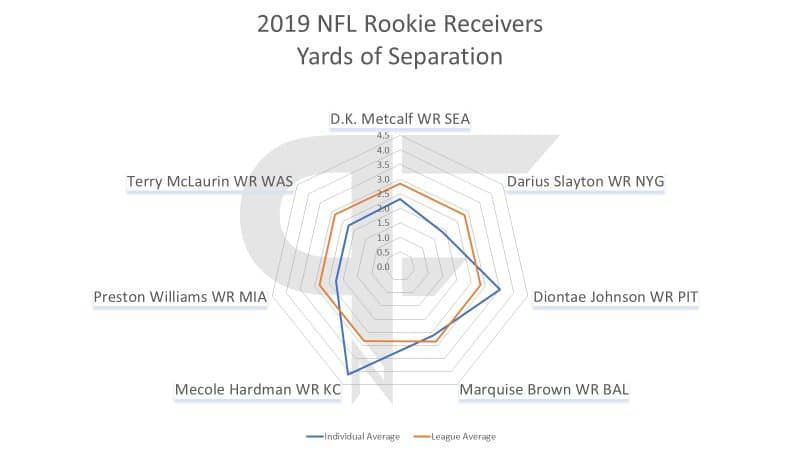
The league average for receivers that qualify weekly for OSM is a little less than three yards. It’s not surprising that, through Week 8, most NFL rookies fall below the league average as the speed of defenders is generally greater in the NFL than in college. However, there are two rookies who stand out. Diontae Johnson (Pittsburgh Steelers) and Mecole Hardman (Kansas City Chiefs) have obtained an astounding 24% and 45% more separation, respectively, compared to others. Both Johnson and Hardman have the ability to overtake defenders for big plays but are often targeted on shorter routes with soft coverage, allowing them to gain speed before defenders can close the gap.
Catch percentage
Catch percentage (or completion %) is one of few traditional statistics that are considered with PFN’s OSM. In general, this is an individual statistic portraying a receiver’s probability of catching the football when targeted. However, it’s also reflective of the opportunity a receiver provides himself due to his behaviors, such as his ability to create separation.
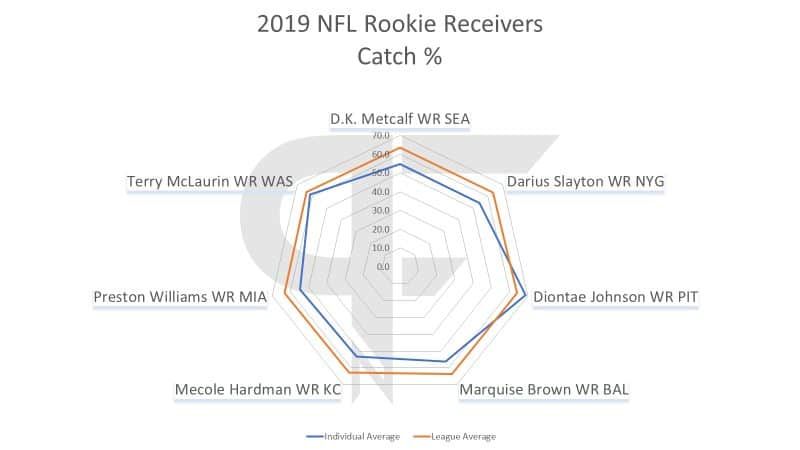
As with separation, it’s not surprising to see most NFL rookies with a lower catch percentage than the league average as veterans have had more time to perfect their skills and adjust to the speed of the NFL. To date, only Diontae Johnson has a higher catch percentage than the league average (nearly 5% higher). Perhaps even more impressive is the fact that he has maintained this success consistently, despite three different quarterbacks throwing him the ball: Ben Roethlisberger, Mason Rudolph and Devlin Hodges.
Yards After Catch
Yards after catch is a primary difference between traditional receiver statistics and those used in determining a receiver’s OSM. As noted earlier, receiving yards combine both air yards prior to completion in addition to yards on the ground after completion. Yards after catch only considers the yards a receiver is responsible for. It can be telling of the primary usage of a receiver in the passing game. It can also be an indicator of a receiver’s ability to make big plays downfield.
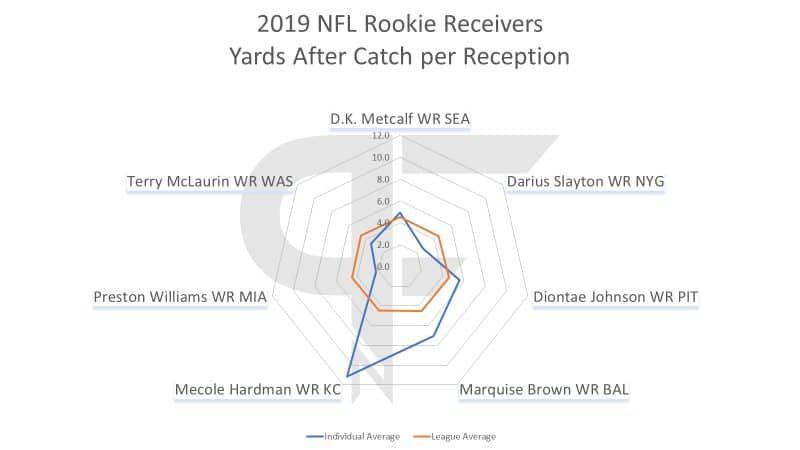
Consider Marquise Brown (Baltimore Ravens) and Mecole Hardman in the chart above. Both have outstanding yards after catch at 7.0 and 11.2, respectively. This is indicative of their big play ability, as well as their speed and agility. However, it is unlikely that either will continue to produce at this level. Outside of his Week 1 performance against the Miami Dolphins, Brown has averaged a pedestrian 2.9 yards after catch when qualifying for OSM. Similarly, Hardman had a great game in Week 3 against Brown’s Ravens, obtaining an average 36.1 yards after catch. Take that away, however, and he is also averaging just 2.9 yards after catch.
Yards After Catch Above Expectation
The NFL tracks all kinds of data via chips in players’ equipment. Numerous tracking points, including a receiver’s speed and the number of nearby defenders, can tell us what the expected yards after catch should be. The below chart illustrates the variance between the actual and expected yards after catch.
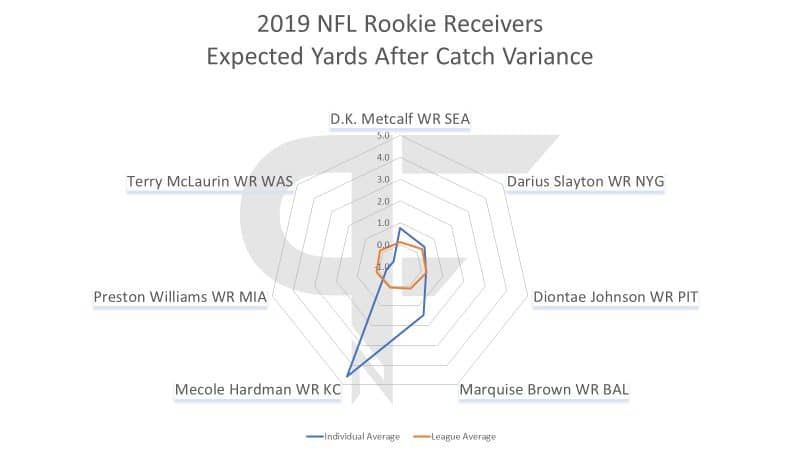
Mecole Hardman’s variance is indicative of a fast receiver that can slip past defenders in the open, evidenced by his 83-yard touchdown catch in Week 3 against the Ravens. The amount of separation he had at the time of completion, along with his speed, allowed him the room necessary to obtain 50 yards after the catch on that one play.
Interestingly, D.K. Metcalf (Seattle Seahawks) gains a full yard beyond expectation on average, even though his separation and catch percentage are both below par. When Metcalf catches the ball, it is usually in stride and his forward momentum allows him to gain extra yardage after contact.
Offensive Share Metric
Although these are only a few of many factors considered in calculating OSM, it’s obvious how each reflects the success of an individual contributing to the production of his team’s offense.
Two rookie receivers stand out when considering the statistics reviewed above. Both Diontae Johnson and Mecole Hardman ranked higher than average in three of the four categories mentioned. So, it’s not surprising that they also have higher than average NFL OSM rookie grades. In fact, they are the only 2019 NFL rookies through Week 8 to do so.
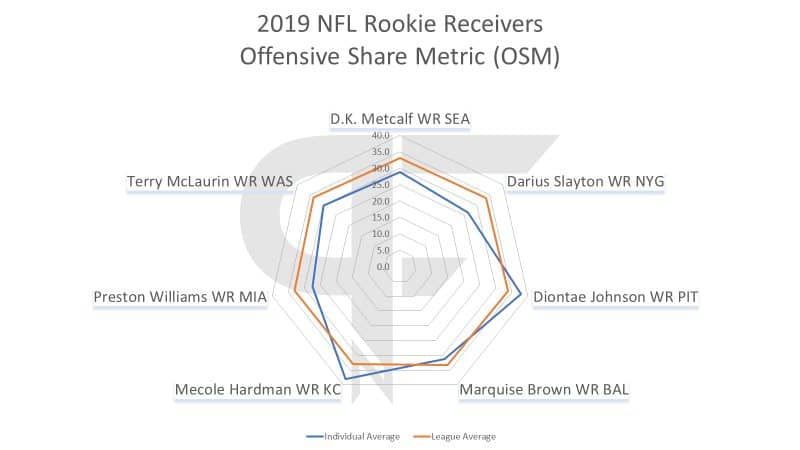
Johnson’s ability to get separation allows him a greater chance to catch the football and gain extra yards. Hardman’s speed allows him to get separation and connect for big plays, contributing to the offense’s ability to score points. It’s unclear if Hardman’s OSM grade will remain above average as he’s struggled to get targets in recent weeks due to the absence of Patrick Mahomes. Johnson, on the other hand, has been a consistent presence in the passing game. It’s almost certain he will continue to be a reliable contributor for the remainder of the season.
Fans and teams alike should have reason to be hopeful and proud of these rising talents. For the Pittsburgh Steelers and Kansas City Chiefs, their ability to draft skilled receivers and develop them into stars continues to impress.
For the latest news and NFL updates, be sure to follow Pro Football Network on Facebook and on Twitter @PFN365.

